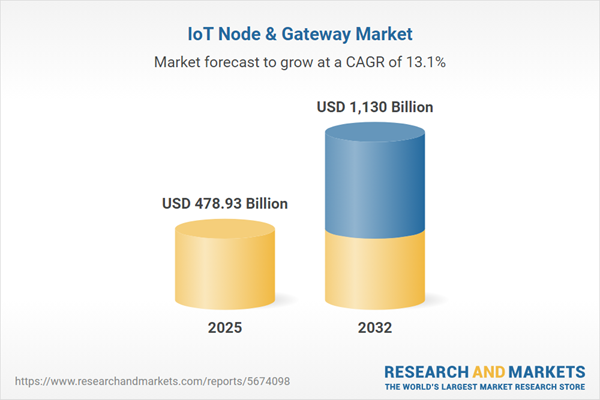Speak directly to the analyst to clarify any post sales queries you may have.
The IoT Node & Gateway Market is enabling enterprise connectivity at scale, serving as the backbone for digital transformation and secure business modernization. This report provides actionable insights to guide senior stakeholders as they chart strategic directions and prioritize investments.
Market Snapshot: IoT Node & Gateway Market Growth and Potential
The global IoT Node & Gateway Market achieved a value of USD 422.70 billion in 2024, with forecasts pointing toward USD 478.93 billion by 2025 and an expected value exceeding USD 1.13 trillion by 2032. Growth in this space is sustained by rising investment in edge computing capabilities and the swift integration of new connectivity solutions spanning manufacturing, healthcare, and urban infrastructure. As organizations scale digital transformation initiatives, they actively seek platforms with modular architecture, robust performance, and flexible integration options. These elements enable enterprises to optimize data management and sustain operational agility in today’s evolving environments.
Scope & Segmentation: Strategic Insights for Enterprise Planning
- Components: Hardware including sensors, processors, actuators, memory, and communication modules, paired with software and services such as consulting, analytics, middleware, deployment, and security, together provide a holistic foundation for asset management.
- Connectivity Technology: Options such as 5G, LTE, Wi-Fi, LoRaWAN, Sigfox, Bluetooth, Zigbee, Ethernet, and powerline meet an array of industry connectivity demands and deployment strategies.
- Applications: Use cases include precision agriculture, healthcare innovation, predictive maintenance, and smart city development, advancing automation and operational safety throughout various sectors.
- End Use Industry: Energy, utilities, healthcare, automotive, electronics, manufacturing, retail, food production, and transportation sectors leverage IoT solutions for improved process visibility, automation, and supply chain efficiency.
- Deployment Model: Enterprises select from cloud-based, hybrid, or on-premises solutions depending on their regulatory, security, or compliance requirements within diverse operating settings.
- Regional Coverage: Analysis spans the Americas, Europe, Middle East & Africa, and Asia-Pacific, highlighting unique regional drivers, regulatory conditions, and methods for international expansion and channel optimization.
- Companies Profiled: Notable vendors such as Cisco Systems, Huawei Technologies, Sierra Wireless, Digi International, Telit Communications, Advantech, MultiTech Systems, Quectel Wireless Solutions, u-blox, and Fibocom Wireless demonstrate expertise in secure, scalable connectivity.
Key Takeaways for Enterprise Leaders
- IoT nodes and gateways form critical integration points, bridging operational technology and IT systems to facilitate straightforward process management and unified data flow for responsive business operations.
- Edge computing adoption enables near real-time analytics and decisions, positioning businesses to react quickly in dynamic operational or market conditions.
- Integrated analytics and secured system management functions lower lifecycle complexity, supporting cost-efficient operations and fostering sustainable growth.
- Collaborative approaches among connectivity providers, semiconductor manufacturers, and IoT vendors drive industry standardization and help accelerate enterprise transformation efforts.
- Enhanced investment in secure, regulatory-compliant infrastructure supports risk mitigation and ensures operational continuity as business landscapes shift.
Tariff Impact on IoT Supply Chains
Recent changes in US trade policy have led organizations to reconfigure their IoT node and gateway supply chains to enhance resilience. Initiatives such as dual-sourcing and near-shoring are emerging to achieve more reliable supply continuity. Moving toward cloud-native architecture and adopting flexible licensing models support efficient cost management and swift adaptation to policy updates. Effective risk management and supply chain redesign help maintain operational consistency despite evolving global conditions.
Methodology & Data Sources
This analysis employs executive interviews, in-depth case studies, and comprehensive reviews of technical and regulatory documentation. The multi-angle perspective ensures executive teams receive insights aligned with the complexities of modern digital transformation and critical investment decisions.
Why This Report Matters
- Leaders access targeted recommendations for building and scaling IoT infrastructure, ensuring resource optimization and strong strategic alignment.
- Decision-makers gain guidance on solution deployment, partner selection, and governance, supporting effective transformation across multiple sectors.
- The report highlights compliance and implementation priorities, equipping executives to implement resilient IoT frameworks in evolving regulatory landscapes.
Conclusion
This report empowers enterprises to create secure, agile IoT ecosystems and achieve better alignment with broader digital strategies. Leaders are supported as they navigate a connected marketplace and pursue sustained operational resilience.
Additional Product Information:
- Purchase of this report includes 1 year online access with quarterly updates.
- This report can be updated on request. Please contact our Customer Experience team using the Ask a Question widget on our website.
Table of Contents
3. Executive Summary
4. Market Overview
7. Cumulative Impact of Artificial Intelligence 2025
List of Figures
Companies Mentioned
The companies profiled in this IoT Node & Gateway market report include:- Cisco Systems, Inc.
- Huawei Technologies Co., Ltd.
- Sierra Wireless, Inc.
- Digi International Inc.
- Telit Communications PLC
- Advantech Co., Ltd.
- MultiTech Systems, Inc.
- Quectel Wireless Solutions Co., Ltd.
- u-blox AG
- Fibocom Wireless Inc.
Table Information
| Report Attribute | Details |
|---|---|
| No. of Pages | 194 |
| Published | November 2025 |
| Forecast Period | 2025 - 2032 |
| Estimated Market Value ( USD | $ 478.93 Billion |
| Forecasted Market Value ( USD | $ 1130 Billion |
| Compound Annual Growth Rate | 13.1% |
| Regions Covered | Global |
| No. of Companies Mentioned | 11 |









